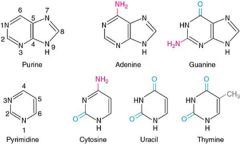![]()
![]()
![]()
Use LEFT and RIGHT arrow keys to navigate between flashcards;
Use UP and DOWN arrow keys to flip the card;
H to show hint;
A reads text to speech;
20 Cards in this Set
- Front
- Back
|
Two experiments establishing DNA is the genetic material (proof) |
Avery, MacLeod and McCarthy experiment (1944): pathogenic S cell (purified) DNA + non-pathogenic R cell -> recombination (transformation)+ cell division -> pathogenic S cell [nonconclusive, purification had contamination] Hershey and Chase experiment (1952): purified radio-labeled phage (+isotope P32/S35) infects bacteria, phage binds to bacteria + blend to break phage particles from outside of bacteria. DNA in phage injected into bacteria, not protein (dislodged) |
|
|
Building blocks of DNA |
Nucleotides DNA: deoxyribonucleic acid RNA: ribonucleic acid |
|
|
Nucleotides |
Purine/pyrimidine, 5 C sugar, P groups (covalently bonded) |
|
|
Bond between sugar and base |
Glycosidic bond |
|
|
Bond between phosphoric acid and sugar |
Ester bond |
|
|
Purines |
Adenine (6 NH2) , Guanine (2 NH2, 6 =O) |
|
|
Pyrimidine |
Cytosine (2 = O, 4 NH2), Thymine (2, 4 =O, 5 CH3), Uracl (2,4 =O) |
|
|
Purine, pyrimidine structure |

|
|
|
Polymer of nucleotide |
Base, sugar, P group Phosophodiester (covalent) bond: 5'P of one nt, 3' OH of second nt Phosphate sugar backbond Sugar Sequence 5' -> 3' |
|
|
Phoebus Levene thoughts on DNA |
DNA = structural molecule, equal stoichiometry = boring, not important |
|
|
Chargaff's rules (1940s) |
1. Purine content = pyrimidine (content) 2. A = T, G = C (content) 3. Base compositions change btwn species = DNA important for species 4. All tissues have same base composition (invariant), all tissue have same information Conclusion: bases play into genetic material |
|
|
Base tautomers exist but... |
But at physiological conditions bases mainly in one exclusive state, no flip flop states "True covalent structure" |
|
|
X-ray diffraction (Franklin) structural info |
DNA crystalline lattice + x-ray= interference pattern = structural info about molecule Helical, 20 A diameter, 3.4 A repeat btwn bases, ~ 36 A repeat (one turn) |
|
|
Watson and Crick conclusion |
Franklin (structural), Chargaff (biochem), + tautomerization (chem)information Double helical, two polymers, anti-parallel, base paired |
|
|
Watson and Crick base pairing |
A - T (2 H bonds, non-covalent, stable) G - C (3 H bonds, non-covalent, stable) Similar shape and size of interactions = DNA has same overall structure, invariant, no sequence specific shape |
|
|
Separate double helix |
Forms template for replication Due to Watson and Crick base pairing |
|
|
Non-covalent interactions in DNA (3) |
H bonding btwn base pairing, base stacking (weak, non-covalent) planar molecular interactions, electrostatic force (P charged) outside of helix (far apart) (energetic contribution) |
|
|
Major and minor grooves |
Major = wider, deeper Minor = narrower (ADA) |
|
|
Sequence specific recognition (proteins + DNA) |
Not on overall structure (invariant) Proteins R groups recognize H donor (D), acceptors (A) in grooves Major groove: bigger, diff patterns Minor groove: pattern of H bonds (ADA) 3D shape w/ H D/A contacts DNA H D/A |
|
|
Nucleic Acid double-helices |
A form: double helical RNA, more squat, wider, diff major/minor grooves B form: in nature Z form: rare/not in nature, can be made in lab Diff shapes from monomers (diff stable configurations) = diff bond angles = diff polymers -> RNA sugar pucker |

